TRIP REPORT: PARIS, THE SEINE, NORMANDY, AND CHARTRES 2018
This month we took a Viking cruise on the Seine river, from Paris to Normandy and back, adding in a side trip to Chartres. The actual distance covered wasn’t a great deal, but we saw a lot thanks to numerous stops along the way in both directions.
 Experience has taught us it’s best to arrive a few days before the cruise because there is almost always a jam-up at the airport for passport control and customs. On one trip we landed at Charles de Gaulle (CDG) about 7:30 AM, along with two or three other jumbo jets: there was one, count ‘em, one passport clerk on duty to handle about a thousand people! In consequence we missed a connecting flight to Marseilles and almost a full day aboard the boat. Now, more savvy, we get there well in advance. So we planned a few days in Paris as a pre-cruise excursion.
Experience has taught us it’s best to arrive a few days before the cruise because there is almost always a jam-up at the airport for passport control and customs. On one trip we landed at Charles de Gaulle (CDG) about 7:30 AM, along with two or three other jumbo jets: there was one, count ‘em, one passport clerk on duty to handle about a thousand people! In consequence we missed a connecting flight to Marseilles and almost a full day aboard the boat. Now, more savvy, we get there well in advance. So we planned a few days in Paris as a pre-cruise excursion.
We always do these trips through Viking and our exceptionally gifted travel agent here in Blacksburg, including the pre-cruise trip. We flew from Dulles in Washington DC (IAD) where we had to do what I call the “Disneyland Rope Dance”: snaking back and forth in taped-off lines to go through “security.” Now, if we really got any security from the TSA I wouldn’t mind this, but there was zero real “inspection” of bags and/or persons. Sometimes I think they don’t even turn the X-ray machines on. TSA seems to me to be a government-employee union jobs program and at best a fig leaf for the incompetence of the administrators.
 Viking is incredibly well organized and efficient and they have enough clout to get us good air fares and hotel choices. For the pre-cruise segment they booked us on Air France (coincidentally, this was the airline I used for my first trip to Paris as a teenager in 1966). Air France is better than some other companies, at least with respect to food, though since they fly the same aircraft everyone else does, I spent a pretty ghastly 8 hours in a coach seat that could have been used by the Spanish Inquisition to interrogate heretics. As a result my right-side sciatica was kicked into high gear and I had a horribly painful leg the whole trip: but I survived to tell the tale (obviously: I’m telling it here, yes?). We landed at CDG in the early morning and were met by Viking’s people, who conveyed us to a very nice hotel on the Boulevard Haussmann, a pretty tony address. We parked our bags and embarked on a bit of sightseeing. Giving in to jet lag on Day One is always inadvisable so we force ourselves onto local time.
Viking is incredibly well organized and efficient and they have enough clout to get us good air fares and hotel choices. For the pre-cruise segment they booked us on Air France (coincidentally, this was the airline I used for my first trip to Paris as a teenager in 1966). Air France is better than some other companies, at least with respect to food, though since they fly the same aircraft everyone else does, I spent a pretty ghastly 8 hours in a coach seat that could have been used by the Spanish Inquisition to interrogate heretics. As a result my right-side sciatica was kicked into high gear and I had a horribly painful leg the whole trip: but I survived to tell the tale (obviously: I’m telling it here, yes?). We landed at CDG in the early morning and were met by Viking’s people, who conveyed us to a very nice hotel on the Boulevard Haussmann, a pretty tony address. We parked our bags and embarked on a bit of sightseeing. Giving in to jet lag on Day One is always inadvisable so we force ourselves onto local time.
There’s a saying that “French women don’t get fat,” and based on several days of direct observation I think that for the most part this is true. Certainly we saw very few who could be called “fat,” and one or two were so willowy that you had to look at them twice to see them once. There were plenty of pudgy touristes, though.
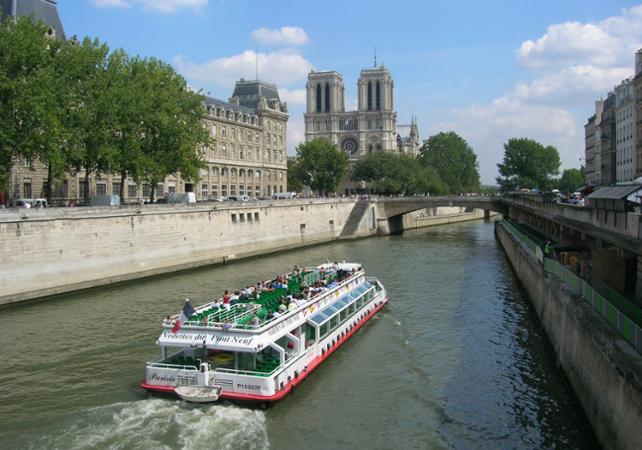 On the first day we took a sightseeing bateau-mouche (“butterfly boat”) ride on the Seine. This might have been considered gilding the lily since we were, after all, going to spend a week on the river; but Viking’s boats can’t come all the way up to Paris proper (the bridges are too low) so we did this classic tourist ride through the city. There was no way were we going to wait to go up in the Eiffel Tower, but the bateau-mouche dock was near it, so we rode the Métro to the nearest stop—which turned out to be a good 1000 yards away from the dock. Upon return to the dock we were pretty well beat so we took a taxi back to the hotel and crashed.
On the first day we took a sightseeing bateau-mouche (“butterfly boat”) ride on the Seine. This might have been considered gilding the lily since we were, after all, going to spend a week on the river; but Viking’s boats can’t come all the way up to Paris proper (the bridges are too low) so we did this classic tourist ride through the city. There was no way were we going to wait to go up in the Eiffel Tower, but the bateau-mouche dock was near it, so we rode the Métro to the nearest stop—which turned out to be a good 1000 yards away from the dock. Upon return to the dock we were pretty well beat so we took a taxi back to the hotel and crashed.
Because my leg was kicking up so badly I’d taken to walking with a cane; and found that there are some advantages in doing so. Upon seeing me hobbling along, the gent at the bateau-mouche ticket office motioned me to the head of the line! Subsequently this happened in other places, and people even yielded a seat to me in the Métro. I may have to start using a cane now that I’m home: it just goes to show you that being old and feeble isn’t entirely a bad thing.
The next day we’d booked a guide to take us through the Marais quarter, a district of Paris with a rich history and one wherein many Jews lived before the Germans came and took them away. Our guide—again arranged by Viking—was a woman who spoke very good English and was clearly knowledgeable about the history and geography of the Marais; she was very much worth her modest fee.  We also visited Ste Chappelle, a smaller church not too far from the much more famous Nôtre Dame Cathedral. It’s known for its stained glass windows and remarkable blue color scheme.
We also visited Ste Chappelle, a smaller church not too far from the much more famous Nôtre Dame Cathedral. It’s known for its stained glass windows and remarkable blue color scheme.  The chapel is located inside a government complex, so we again had to go through “security,” which demonstrated that the French take this (at least at tourist sites) no more seriously than the TSA does. We ate lunch in an outdoor café on the bank of the river, during which a remarkable thing happened. As we were sitting there a man walked past and snatched some bread from the basket we had on our table! Just walked by and grabbed it without stopping, not so much as a by-your-leave. I felt that if he was so hungry he had to steal bread from tourists he needed it more than I did, and he was welcome to it, but it was a bit off-putting. If he’d asked I’d have given it to him.
The chapel is located inside a government complex, so we again had to go through “security,” which demonstrated that the French take this (at least at tourist sites) no more seriously than the TSA does. We ate lunch in an outdoor café on the bank of the river, during which a remarkable thing happened. As we were sitting there a man walked past and snatched some bread from the basket we had on our table! Just walked by and grabbed it without stopping, not so much as a by-your-leave. I felt that if he was so hungry he had to steal bread from tourists he needed it more than I did, and he was welcome to it, but it was a bit off-putting. If he’d asked I’d have given it to him.
 There are any number of beggars in Paris. You would think that in France, a country which has what is in essence a Socialist mindset and government (no matter what party is in power) this wouldn’t be the case, but they’re very common: no matter how high-end the area may be. In fact there are support systems available, as these two articles from the Internet show, but it seems to make no difference. Some of them had dogs, and while as a rule I don't give money to beggars, I'm a sucker for dogs; so if there was a dog I'd drop some change in the hat and say "Pour votre chien," because even if the man didn't deserve a handout, the dog certainly did.
There are any number of beggars in Paris. You would think that in France, a country which has what is in essence a Socialist mindset and government (no matter what party is in power) this wouldn’t be the case, but they’re very common: no matter how high-end the area may be. In fact there are support systems available, as these two articles from the Internet show, but it seems to make no difference. Some of them had dogs, and while as a rule I don't give money to beggars, I'm a sucker for dogs; so if there was a dog I'd drop some change in the hat and say "Pour votre chien," because even if the man didn't deserve a handout, the dog certainly did.
Paris is also infested with pickpockets, and we were repeatedly warned about them. They tended to be pairs of young people. One distracts the mark by pretending to be “taking a survey,” carrying a clipboard to cover the “lift” by the other member of the pair. Once warned about the clipboard trick we found them easy to spot and avoid. One tried for the cell phone I wear on my belt but all he got was an elbow in his ribs for his trouble, causing him to drop his clipboard. Pickpockets are especially common around such tourist attractions as the Galeries Lafayette, a very high-end department store that was a couple of blocks from our hotel.
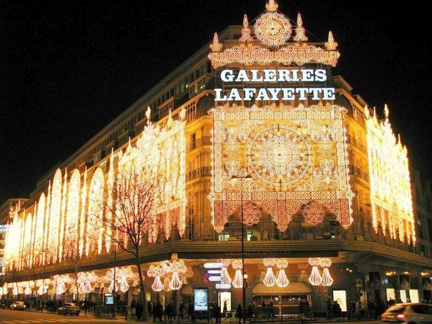 The Galeries Lafayette is a huge place with every high-dollar (well, high-Euro) brand name item you ever heard of. It's actually a nationwide chain, sort of like Macy's. We ran across their stores in other places besides Paris.
The Galeries Lafayette is a huge place with every high-dollar (well, high-Euro) brand name item you ever heard of. It's actually a nationwide chain, sort of like Macy's. We ran across their stores in other places besides Paris.
We were quite close to the huge main store on the Boulevard Haussmann, so wandered in to see what we could see. Inside it was packed to the rafters with Asian tourists, hordes of them buying stuff and more hordes waiting in line to do so. Inside the store proper there are smaller sub-stores devoted to specific brands of expensive perfumes, leather goods, clothing, etc. These areas are roped off and guarded by supercilious clerks who see to it that only a few people are let in at a time, presumably to minimize shoplifting. We spent a few minutes looking around, but no Euros!
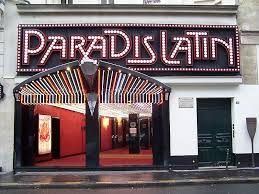 One night Viking had set us up to go to a cabaret show at a place called “Paradis Latin,” in the famous Latin Quarter. This show was…well, it was exactly what you would expect of a Parisian night club. We were served an excellent meal of Chateaubriand, along with a bottle of wine and one of champagne for each couple; and the show itself was mainly very beautiful nearly-naked women engaged in energetic dancing, plus baggy-pants comedians telling jokes in French. Seated at our table was another couple from the Viking group: both of them in their 80’s, and—I am not making this up—newlyweds! They were a lot of fun to be with and acted more like teenagers than a couple in their dotage. On the whole, though I didn’t understand the jokes (my French is good enough for restaurants and taxis but it isn't up to the standards of a French nightclub) it was very enjoyable; and frankly, those ladies on stage made me proud to call myself a mammal.
One night Viking had set us up to go to a cabaret show at a place called “Paradis Latin,” in the famous Latin Quarter. This show was…well, it was exactly what you would expect of a Parisian night club. We were served an excellent meal of Chateaubriand, along with a bottle of wine and one of champagne for each couple; and the show itself was mainly very beautiful nearly-naked women engaged in energetic dancing, plus baggy-pants comedians telling jokes in French. Seated at our table was another couple from the Viking group: both of them in their 80’s, and—I am not making this up—newlyweds! They were a lot of fun to be with and acted more like teenagers than a couple in their dotage. On the whole, though I didn’t understand the jokes (my French is good enough for restaurants and taxis but it isn't up to the standards of a French nightclub) it was very enjoyable; and frankly, those ladies on stage made me proud to call myself a mammal.
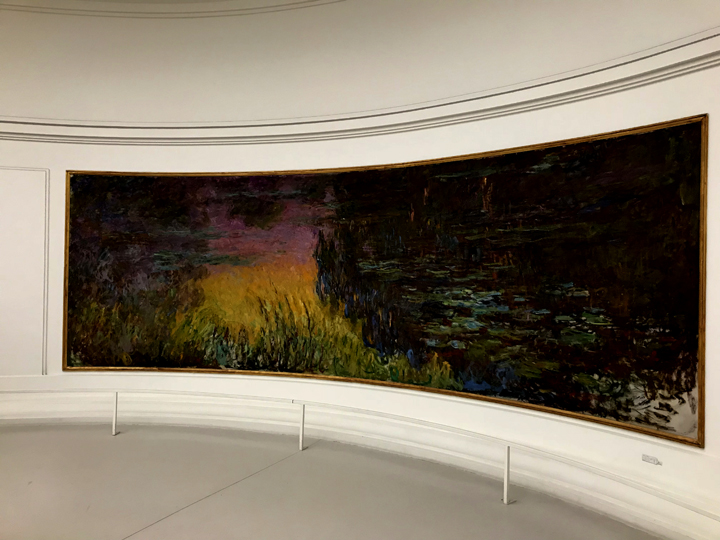 My sister had had recently been to Paris and she'd recommended we visit a museum dedicated to the Impressionist painter Monet: L’Orangerie. This was originally built as a greenhouse to protect imported orange trees from the winters of Northern France; it’s far and away the most elegant greenhouse I’ve ever seen, but now it’s an art museum. We had audio guides with running commentary on the paintings we saw. These comments made me wonder why people who talk about art are so amazingly pretentious, even worse than wine critics. I’ve never understood why a painting can’t be accepted for what it is and what the viewer sees in it, why it has to be “interpreted” and layer upon layer of “meaning” attributed to it.
My sister had had recently been to Paris and she'd recommended we visit a museum dedicated to the Impressionist painter Monet: L’Orangerie. This was originally built as a greenhouse to protect imported orange trees from the winters of Northern France; it’s far and away the most elegant greenhouse I’ve ever seen, but now it’s an art museum. We had audio guides with running commentary on the paintings we saw. These comments made me wonder why people who talk about art are so amazingly pretentious, even worse than wine critics. I’ve never understood why a painting can’t be accepted for what it is and what the viewer sees in it, why it has to be “interpreted” and layer upon layer of “meaning” attributed to it.
 One modern painting in the collection had an especially annoying commentary. It was a group of daubs that could have been made by a kindergartner, but the commentary waxed lyrical about it and described it as an "homage" to Monet’s imagery. I include a picture of this “art” and my readers can make up their own minds about whether or not it’s some sort of practical joke by the “artist,” who was undoubtedly paid a handsome sum by the museum.
One modern painting in the collection had an especially annoying commentary. It was a group of daubs that could have been made by a kindergartner, but the commentary waxed lyrical about it and described it as an "homage" to Monet’s imagery. I include a picture of this “art” and my readers can make up their own minds about whether or not it’s some sort of practical joke by the “artist,” who was undoubtedly paid a handsome sum by the museum.
Monet was clearly an obsessive compulsive individual. He had this “thing” about the water lilies in the pond on his property, painting them over and over and over again, at all seasons of the year and at all times of day; dozens of paintings of water lilies, mostly on canvases that were perhaps 30 feet long. Most of the paintings were indistinguishable one from the other, to my Philistine way of thinking. I mean, plants are plants, even if they’re water plants. You’ve seen one water lily, you’ve seen them all. Similarly, Monet painted the facade of Rouen Cathedral thirty times. I’m not an art expert and honestly I can’t see what the fuss is about his work. As it happens, later in the trip we went to the actual water garden on the property he owned, and there were saw the actual water lilies he painted (well, the descendants thereof) and damned if they didn’t look like every other water lily I’ve ever seen.

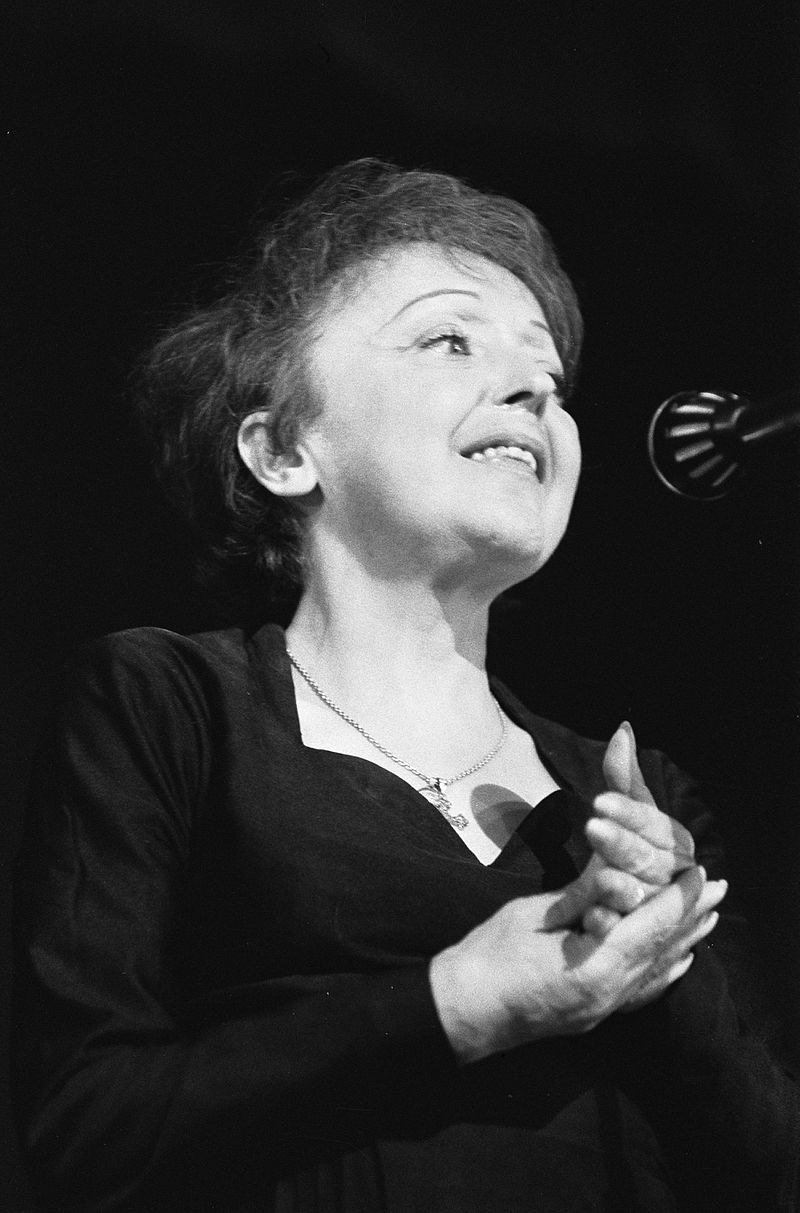 We had hoped to see the Opera Garnier, but it was closed, so that had to be saved for the return to Paris (see below). Instead we took the Métro to the Pere Lachaise Cemetery. Many famous people are buried there, including such luminaries as Oscar Wilde and the “Doors” singer Jim Morrison. The grave I wanted to see was that of Edith Piaf, the iconic French singer whose rendition of “La Vie en Rose” is so closely associated with France (especially Paris) that it is played even more than “La Marseillaise.” She is without doubt the most famous “resident” of this necropolis, and her grave is kept more or less as a shrine, where fans (most of whom were born after her death) leave flowers and tributes. We saw the same phenomenon in Buenos Aires at Eva Peron’s tomb.
We had hoped to see the Opera Garnier, but it was closed, so that had to be saved for the return to Paris (see below). Instead we took the Métro to the Pere Lachaise Cemetery. Many famous people are buried there, including such luminaries as Oscar Wilde and the “Doors” singer Jim Morrison. The grave I wanted to see was that of Edith Piaf, the iconic French singer whose rendition of “La Vie en Rose” is so closely associated with France (especially Paris) that it is played even more than “La Marseillaise.” She is without doubt the most famous “resident” of this necropolis, and her grave is kept more or less as a shrine, where fans (most of whom were born after her death) leave flowers and tributes. We saw the same phenomenon in Buenos Aires at Eva Peron’s tomb.
The next day we boarded the ship, which was docked downriver a ways. Before doing so we had an interesting tour of the suburb St Germaine-en-Laye, nearby, guided by an attractive (and decidedly non-fat) French woman whose English was flawless, very nearly better than mine. Showing us around and discussing the World War Two history of the town she described how the Germans had installed their regional government there and to protect themselves built gun emplacements in bunkers; but she pronounced that word “boonker,” just about the only way you could tell she wasn’t a native speaker of English.

Thence to Viking Rolf, our home for the next week. These river cruisers aren’t really "ships" in either a nautical or technical sense. They’re elegantly-upholstered self-propelled flat-bottomed barges, fitted up to serve the expectations of well-heeled tourists. Since they never leave the relatively shallow river they have no keel and of course have no facilities for making water on board (as ocean ships must do). At each stop they replenish water and supplies for the next stage. They’re quite long and narrow: a bit over 400 feet by about 40 feet. They are built and flagged in, of all places, Switzerland. The Swiss flag flies from the stern and they’re home-ported in Basel. How they get to France I don’t know, but they’re either brought in via the European river-and-canal network or perhaps transported on special heavy-lift ships: I doubt you could ever take one of these into the open ocean: any decent sized wave would snap it in half.
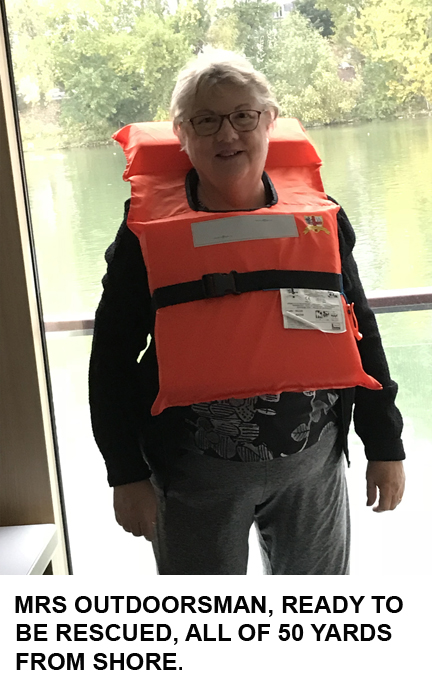 Before leaving regulations mandate an "abandon ship" drill be held, in which all passengers are required to wear life jackets and assemble at their assigned stations. This we did, though considering that we were never more than 100 yards from the well-populated river banks on either side, and that the water is at most 12-15 feet deep, it seemed most unlikely that anyone would have trouble getting saved if somehow the boat foundered.
Before leaving regulations mandate an "abandon ship" drill be held, in which all passengers are required to wear life jackets and assemble at their assigned stations. This we did, though considering that we were never more than 100 yards from the well-populated river banks on either side, and that the water is at most 12-15 feet deep, it seemed most unlikely that anyone would have trouble getting saved if somehow the boat foundered.
The food on board is excellent, and the staff attentive and courteous. Every morning there is a gargantuan breakfast buffet; most days a gigantic lunch buffet; and dinners in the evenings are served from a menu that features regional specialties. After a brief “port talk” about the next day’s events entertainment is provided. One night this was a pair of singers from the Paris Opera (who, inevitably, sang “La Vie en Rose” among other pieces). They were very good: after their performance I suggested they ought to have done “La Marseillaise,” and the very next person who came up suggested the same thing!
The first day of the cruise we stayed moored so that those who hadn’t come early got a day in Paris. We rode in on the Viking bus and went off on our own, though we did go to Nôtre Dame Cathedral.
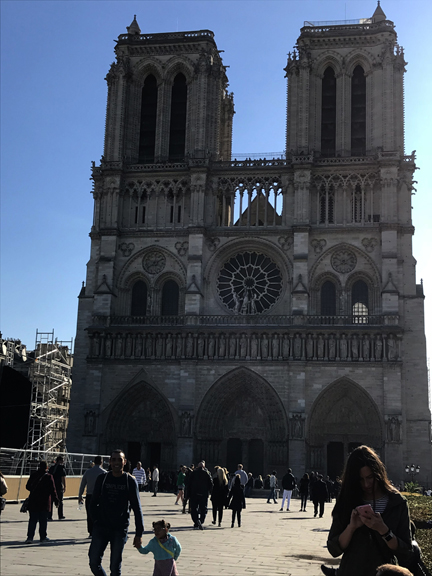

We had chosen to travel in October to avoid the colossal crowds of the “high season,” but nevertheless Nôtre Dame was pretty well filled with tourists. We found a couple of seats and listened to a teenage girls’ choir for a while; afterwards dropping 41 Euros on lunch in a café nearby. Thence to a museum of the Middle Ages which had an interesting exhibit on the history and significance of—wait for it—unicorns. Viking picked us up again at a pre-arranged stop near a statue of Winston Churchill. This wasn’t too far down the street from one of Charles de Gaulle, but far enough that they didn’t have to talk to each other.
We cast off that night and headed down river, where our first stop was in Giverney, a small town where Monet (who else?) had lived and where he had his water garden.

There were water lilies all right; and gazillions of land flowers as well. The land plants were not, as in 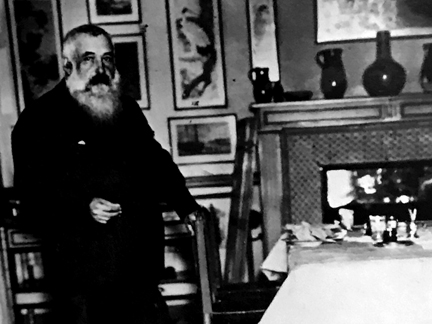 English gardens, in
English gardens, in 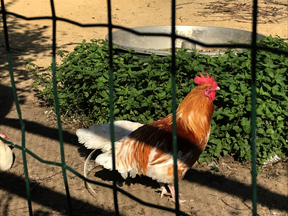 disciplined ranks and rows by type; rather they were all crowded in upon one another higgledy-piggledy, but we were supposed to admire them, so we dutifully did so. The Monet site was also heavily attended by Asian tourists, who crowded the narrow paths around the famous water gardens and made me grateful that we had chosen the off season, or we’d probably have been knocked into the pond.
disciplined ranks and rows by type; rather they were all crowded in upon one another higgledy-piggledy, but we were supposed to admire them, so we dutifully did so. The Monet site was also heavily attended by Asian tourists, who crowded the narrow paths around the famous water gardens and made me grateful that we had chosen the off season, or we’d probably have been knocked into the pond.
Monet bought this house after he had, as the guide put it, "Come into some monnaie! " (I don't normally "get" puns in French but that one I did.) We saw nearly all of it: Monet's bedroom, Monet's kitchen, Monet's studio, Monet's dining room, Monet's stove, and even Monet's rooster. We did not, however, get to see Monet's bathroom.
The next stop that day was Vernon, a pretty place which we were told was much less expensive than Ste-Germain-en-Laye. One reason, perhaps, was, as our guide put it, in Vernon we were likely to encounter “…badly educated dogs…” being walked; but living as we do with two very badly educated dogs ourselves, we didn't have a problem with that. That night we had a “Taste of Normandy” menu on board, which included mussels. I love mussels but from time to time I’ve had a bad experience with them; ignoring my wife's predictions of gastrointestinal destruction I took the chance and paid no penalty for my temerity.
The following day was what we’d really come to see: the invasion beaches and the American military cemetery. The beaches were actually two hours away from where the ship was docked; so we got up at the Crack of Dawn, and I was grateful that the long ride gave me a chance to catch some Z’s.

The military cemetery at Colville-sur-Mar was very sobering. There are 9500+ graves; the average age of those interred is 24.


As we entered we took part in a recognition ceremony for one of the passengers in our ship; it was held in front of the reflecting pool shown above. This lady's uncle had won the Medal of Honor at Omaha Beach, and the cemetery officials held this ceremony in his honor, with the niece accepting a bouquet of flowers. We were then each given flowers to place on graves, which everyone did.
We stopped for lunch at a very posh golf club and back to the ship after a 12-hour day. Our guide on this run was pretty knowledgeable, but I told her something she didn’t know: there is one, count ‘em, one ship that was in the invasion fleet still in service. Launched as LST-510, she is now Cape Henlopen, in ferry service between Orient Point NY and New London CT. She’s the last survivor of the invasion fleet. We have crossed Long Island Sound in her; she flies a French flag on her bow and proudly displays her battle ribbons.

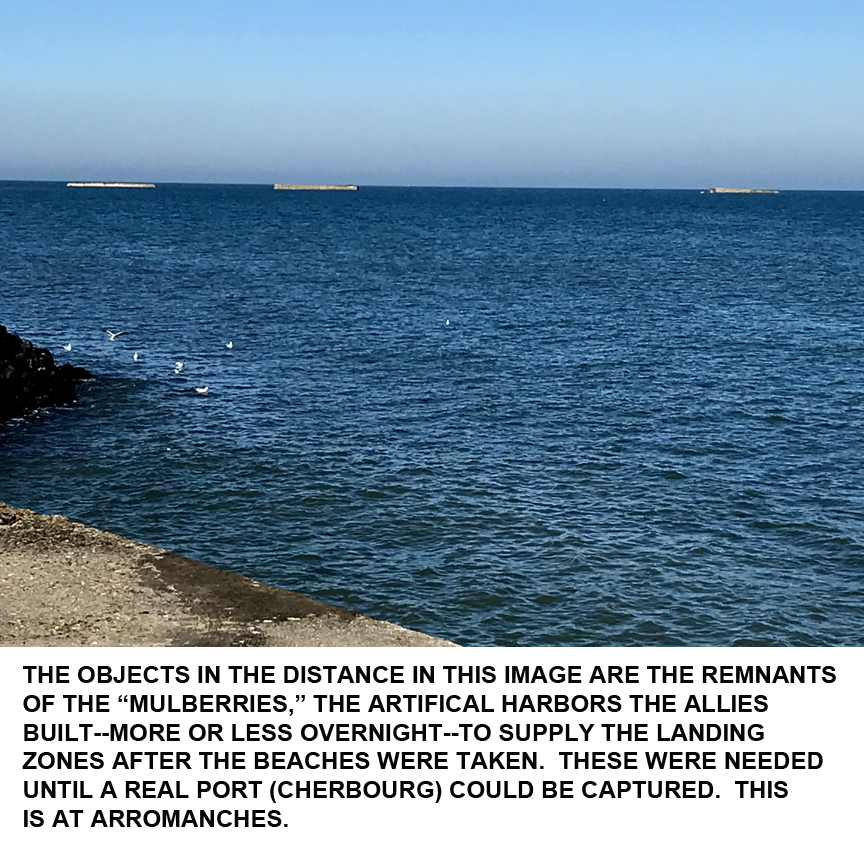
The Germans built their defense installations on the "Atlantic Wall" to last: most of them are still there, albeit much the worse for wear after a colossal bombardment and 70+ years of wear and tear from the elements. No doubt they'll be there many years longer.
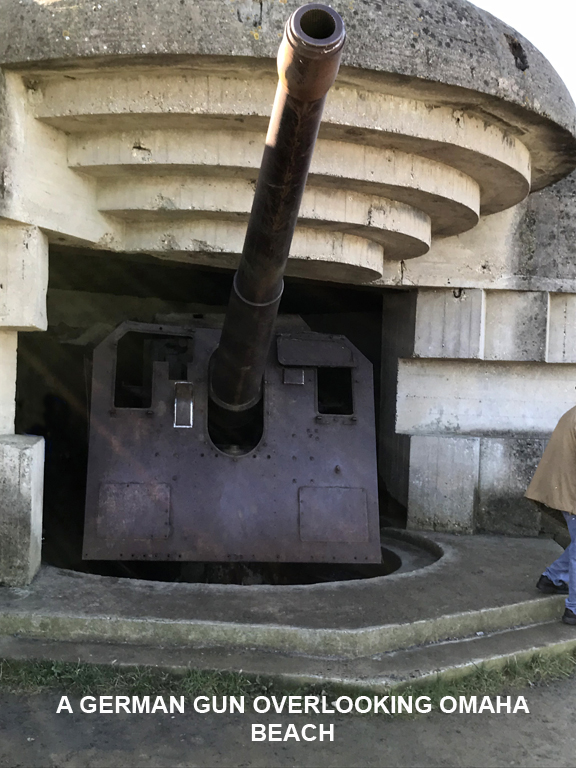
The people of Normandy remember and are grateful for the sacrifices made by American, British, Canadian, Belgian, Polish, and French troops on D-Day; many memorials have been raised to commemorate the landings and a very well-done museum lays out the events of D-Day in detail. Whatever else may be said about the French, they don't forget.

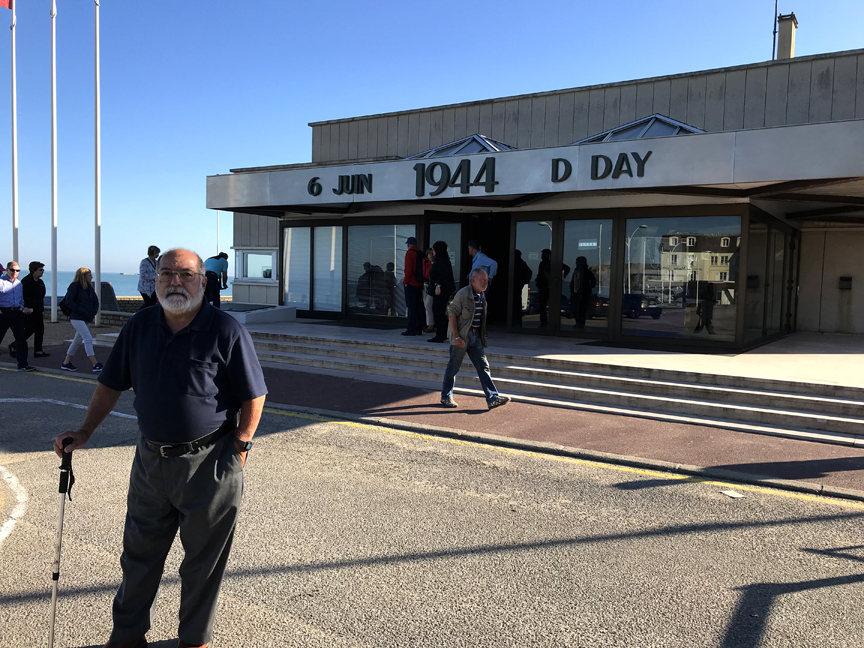
The next day we went to Rouen. This city is famous for its Cathedral (which Monet painted 30 times) and also as the place where the wicked English burned Joan of Arc. We saw the Cathedral's famous facade, and entered via a courtyard which was near but not actually at the place where St Joan was killed.
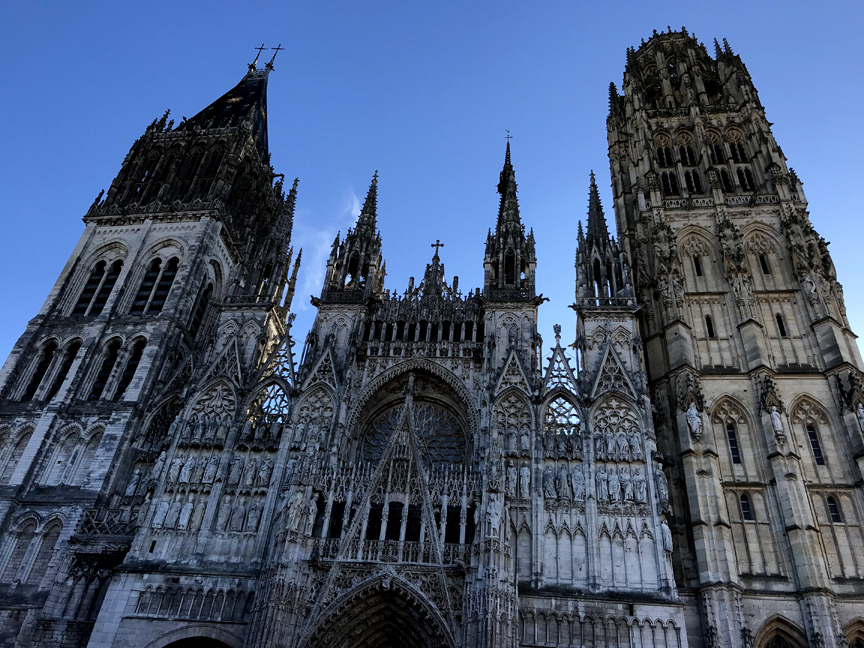


That afternoon was another high point of the trip: a visit to a farm where apples are raised and made into cider and Armagnac, the apple brandy of Normandy. It was a gorgeous day in beautiful countryside sprinkled with apple orchards and herds of Norman cows. This farm was very rustic, and looked exactly like I'd pictured a Normandy farm to look like, 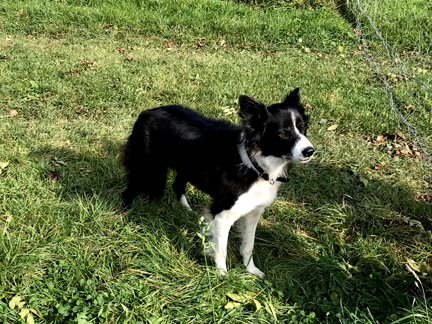 right down to the sheep the lady who ran it kept as "lawn mowers." Naturally, since she had sheep, she also had a lovely Border Collie (who looked just like my Lucy) and all in all it was a very idyllic setting on a perfect day.
right down to the sheep the lady who ran it kept as "lawn mowers." Naturally, since she had sheep, she also had a lovely Border Collie (who looked just like my Lucy) and all in all it was a very idyllic setting on a perfect day.
Regrettably our guide on this excursion was a “natural foods” freak who spent most of her time discussing how “bad” the food that most people eat is, and how they should only eat “good” food, i.e., food made with “real” ingredients, etc., etc. Everyone has encountered someone like this woman, but such people never explain how normal people with normal incomes are supposed to eat “real” food given the staggering prices of anything edible in France that isn’t purchased in a Monoprix Supermarché (where, of course, only “bad” food is sold). Gasoline is expensive enough at about $7 per US gallon; but when hamburger costs 12 Euros per kilo (a bit more than $8 per pound) and everything else is along the same lines, you wonder how people survive.

I have to agree, though, that France is a place where (if you can afford it) you could eat yourself to death and die happy. We stopped and looked at many food stalls in the various towns we visited: there were always mouth-watering displays of meat, vegetables, cheese, fruit, and...bread. The bread in France, anywhere in France, is to die for. Nobody in France bakes bread at home, it's a specialized trade that is carried on by artisan boulangers. The first thing most people do in the morning is to visit the bakeries and buy their daily croissants and loaves. There are some supermarkets ("Monoprix" is one, we saw them in several towns) but most people seem to buy stuff at specialty stores. The guide's resentment may be understood in terms of a general dislike of change. I'm skeptical that places like Monoprix sell food that is inherently "bad," and also that uniformly, across the board and without exceptions, small mom-and-pop shops sell "good" food. That said, I do like the idea of specialty stores.



We did see something approaching “real life in France” when somewhere we stopped in another small town where it was market day: vendors had set up stalls in the main square, selling everything needed for daily life: TV sets, kitchen utensils, toys, garden tools, items of food, plus clothing, both new and used.
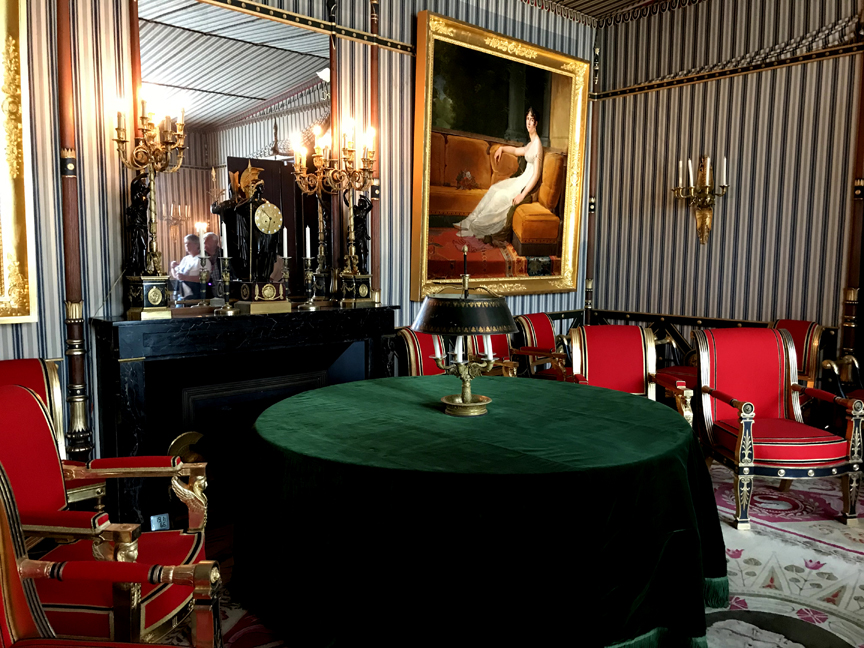
Saturday we made an afternoon visit to the home Napoleon Bonaparte had shared with his wife Josephine. It was, by modern standards, a pretty fancy place, though nowhere near so opulent as the Royal palace at Versailles (when you see Versailles, you understand just why there was a French Revolution). The over-riding impression we got was that Josephine de Beauharnais may have been beautiful, but she was an extraordinarily extravagant bitch as well. Apparently she wanted the house, Napoleon didn’t; so while he was away conquering Egypt (fat lot of good that did him, he later lost it to the English) Josephine went ahead and bought the place on a mortgage he had to pay off. Then she went ahead and redecorated it to her taste and stuck him with the bills. She was, as the saying goes, a “high-maintenance woman,” to be sure.

We saw Napoleon's office (above) from which he directed the course of the Empire; we saw Napoleon's bedroom, Napoleon's parlor, Napoleon's dining room, and Napoleon's bedroom. We did not see Napoleon's toilet.
Upon returning to Paris we went to the Montparnasse train station to go to Chartres. Gare Montparnasse is the largest station in Paris and an utter madhouse. It is—like everything else in Paris—undergoing renovation and reconstruction, and it was the one place where no one seemed to speak any significant level of English. Nor were the signs helpful even though I could read them: the place is so enormous that there are several levels for the trains to arrive and depart. Knowing the track number wasn’t much help because we didn’t know what “Halle” was the correct one. Eventually with the assistance of a guide we made our way to the proper train and rode to Chartres, whose train station was tiny but had its own drawbacks, mainly a complete lack of elevators and lots of stairs.
France isn’t a good place to be handicapped, and most especially not a good place to be in a wheelchair. Nearly every tourist site requires you to go up and down steps, many of them spiral stairways so narrow a mountain goat would find them daunting. Furthermore the French love of extensive vistas means you sometimes have to hoof it a long way. I mentioned the thousand-yard walk to get to the butterfly boats, but we also had to deal with several sets of impressive stone steps just to get to the riverbank; then we had to get back up on return. That wasn’t an unusual situation. How handicapped people manage the subways I don’t know.
Paris is a big city. Having grown up in New York City I can manage traffic, smoke, dirt, noise, and throngs of people; I started riding NYC’s subways as a small child and the Paris Métro is a piece of cake. But 40 years of living in small towns have spoiled me and it takes a day or two for me to re-adjust. I was glad to get to Chartres, a very small and quiet place with a magnificent Medieval Cathedral we’d seen many years ago but wanted to see again.


Chartres' Cathedral was spared from destruction in World War Two and is one of the largest, oldest, and best preserved in the world. The guide was a Mr Malcolm Miller, who is a legend in the tourist industry. He’s in his 80’s now but has been guiding at  Chartres for 65 years and is the world’s leading authority on the Cathedral, its history, its architecture, and significance.
Chartres for 65 years and is the world’s leading authority on the Cathedral, its history, its architecture, and significance.
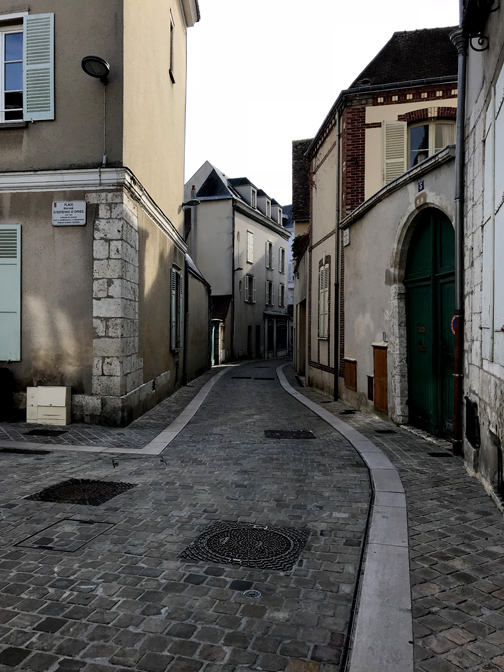 When we arrived there were a thousand or more Scouts, boys and girls from all over Europe ranging in age from about 8 to 18. They were all in the building attending a Mass and had left their backpacks outside, hundreds upon hundreds of them piled up. We were told these were “pilgrims,” actually. After an hour or so they came streaming out in orderly groups, waving flags and singing, though I don’t know if they were singing religious, patriotic, or scouting-camp songs. Certainly none of them were singing “La Marseillaise” or “La Vie en Rose,” anyway. They picked up their packs and off they trooped to wherever they were staying, in perfect order, and we went in to
When we arrived there were a thousand or more Scouts, boys and girls from all over Europe ranging in age from about 8 to 18. They were all in the building attending a Mass and had left their backpacks outside, hundreds upon hundreds of them piled up. We were told these were “pilgrims,” actually. After an hour or so they came streaming out in orderly groups, waving flags and singing, though I don’t know if they were singing religious, patriotic, or scouting-camp songs. Certainly none of them were singing “La Marseillaise” or “La Vie en Rose,” anyway. They picked up their packs and off they trooped to wherever they were staying, in perfect order, and we went in to  hear Mr Miller’s talk and explanation of the stories told in the stained glass windows.
hear Mr Miller’s talk and explanation of the stories told in the stained glass windows.
We saw some very interesting things in Chartres, including a modern-minded nun who valued foot comfort and clearly felt that it was not in conflict with her holy mission; I can only speculate on what the Draconian sadists who ran my grammar school with a ruler of iron would have said about that. Sister Marguerite, in particular, would surely have branded this woman a heretic, but hey, this is France.
Chartres Cathedral has many statues and memorials but one of the oddest is the "tomb" of a body part. Richard The Lionhearted's....heart. When he died they removed this and it is interred in a very elegant sarcophagus in the cathedral: the King had a special affection for Chartres, and as the saying goes, his "heart was there." Literally as well as metaphorically. I don't know where the rest is.
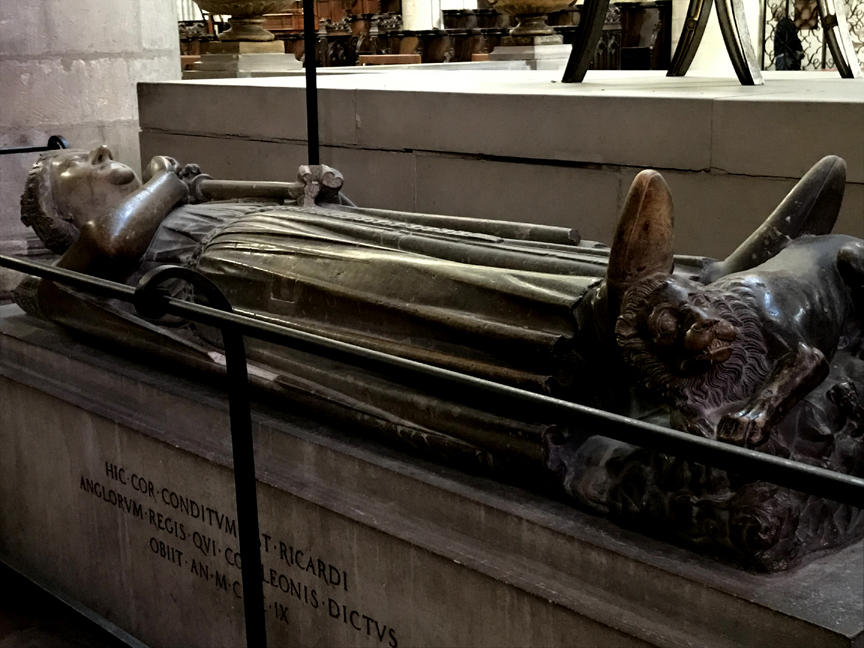
 That night I had an interesting dinner. I spotted an item on the menu of andouillette, and ordered it. Now, “andouille” is a form of spicy sausage I like a great deal, but andouillette isn’t quite the same. It’s sausage, all right: but instead of a pig’s intestine stuffed with spiced ground meat, it’s a pig’s intestine stuffed with….a pig’s intestines. It’s a sort of grilled tripe-filled-with-tripe. A little chewy but good, and unlike the flaccid so-called “pork” we get in the USA, it actually tasted like pork. It was very flavorful and I would certainly order it again. Not so the dish my wife had the second night: rognon de veau. I knew the word “veau” mean “veal” but I didn’t know the word “rognon,” which turned out to be kidneys. Stewed calf kidneys. Kidneys. These had a sort of rubbery consistency, and were more or less flavorless: they didn’t even taste of urine, which might have been expected. It was a very disappointing dish and neither of us liked it. But one of the reasons to travel is to experience new things, right?
That night I had an interesting dinner. I spotted an item on the menu of andouillette, and ordered it. Now, “andouille” is a form of spicy sausage I like a great deal, but andouillette isn’t quite the same. It’s sausage, all right: but instead of a pig’s intestine stuffed with spiced ground meat, it’s a pig’s intestine stuffed with….a pig’s intestines. It’s a sort of grilled tripe-filled-with-tripe. A little chewy but good, and unlike the flaccid so-called “pork” we get in the USA, it actually tasted like pork. It was very flavorful and I would certainly order it again. Not so the dish my wife had the second night: rognon de veau. I knew the word “veau” mean “veal” but I didn’t know the word “rognon,” which turned out to be kidneys. Stewed calf kidneys. Kidneys. These had a sort of rubbery consistency, and were more or less flavorless: they didn’t even taste of urine, which might have been expected. It was a very disappointing dish and neither of us liked it. But one of the reasons to travel is to experience new things, right?
After 2 nights in Chartres we headed back to Paris and were dumped willy-nilly into the shambles of Montparnasse again. We were supposed to have been met but there was nobody holding a sign with our name on the platform so again I went off in search of assistance, which wasn’t forthcoming, for the reasons stated above. By the time I got back, however, our 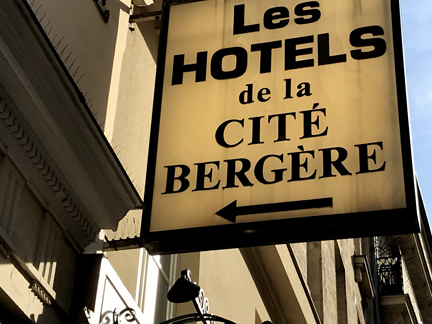 driver had showed up, very apologetic because he’d been held up in the insane Parisian traffic and had had to park “a long way away”. Boy, did he ever: we must have hoofed it through 2 kilometers (no kidding) of the train station before we got to his car, all the while dragging luggage through a steel-and-glass rabbit warren, never once getting outdoors. I don't know how he found his way to the car without a GPS, actually. He drove us to a hotel which was pretty bare-bones but spotlessly clean and very comfortable. It was in the Cité Bergère, a very quiet side alley coming off a main street with the usual roaring traffic. Around the corner we went to a restaurant where I had an item on the menu that translated as “mouse of lamb.” Wondering what on earth that might be, I ordered it: it was a small lamb shank. Looking at it, a triangular chunk of meat with a long bone sticking out like a tail, it did look a bit like a mouse, and was very good.
driver had showed up, very apologetic because he’d been held up in the insane Parisian traffic and had had to park “a long way away”. Boy, did he ever: we must have hoofed it through 2 kilometers (no kidding) of the train station before we got to his car, all the while dragging luggage through a steel-and-glass rabbit warren, never once getting outdoors. I don't know how he found his way to the car without a GPS, actually. He drove us to a hotel which was pretty bare-bones but spotlessly clean and very comfortable. It was in the Cité Bergère, a very quiet side alley coming off a main street with the usual roaring traffic. Around the corner we went to a restaurant where I had an item on the menu that translated as “mouse of lamb.” Wondering what on earth that might be, I ordered it: it was a small lamb shank. Looking at it, a triangular chunk of meat with a long bone sticking out like a tail, it did look a bit like a mouse, and was very good.
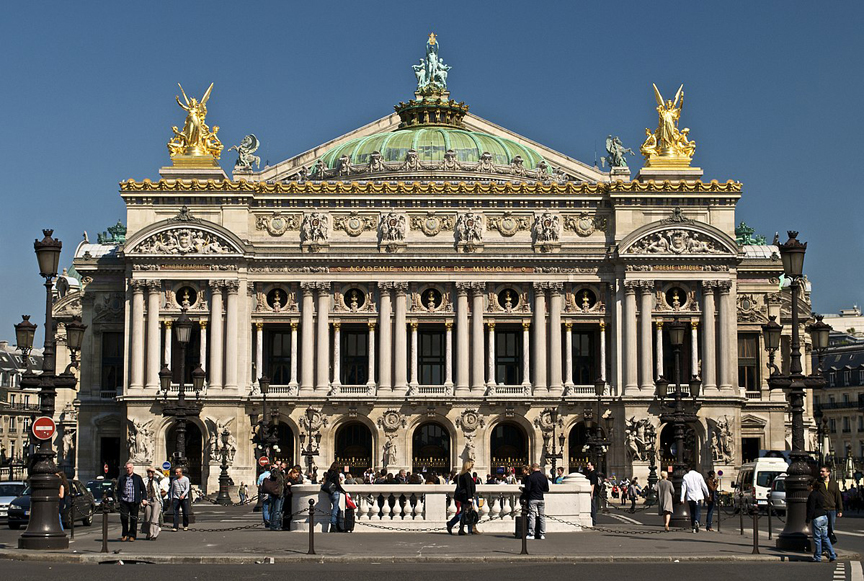
We’d missed the Opera Garnier the first few days but on return we bought tickets and toured it. Very impressive Second Empire architecture, but unfortunately by the time the Opera was opened the Second Empire had vanished under the guns of the Prussians in the war of 1870-71. Nevertheless it was completed and opened, but Garnier, the architect (who had of course worked for Emperor Napoleon III who’d commissioned its construction), wasn’t invited to the opening! He had to buy his own ticket to the building he’d designed. My late mother would have described the building as “ungapachka,” a word she had that means “ornate beyond reason”. It certainly was…something to see. Marble, granite, gold leaf, precious stones, and who knows what else. Well, when you’re an Emperor there is no reason not to spend as much as you want and even less reason to worry about whether the result is in good taste.
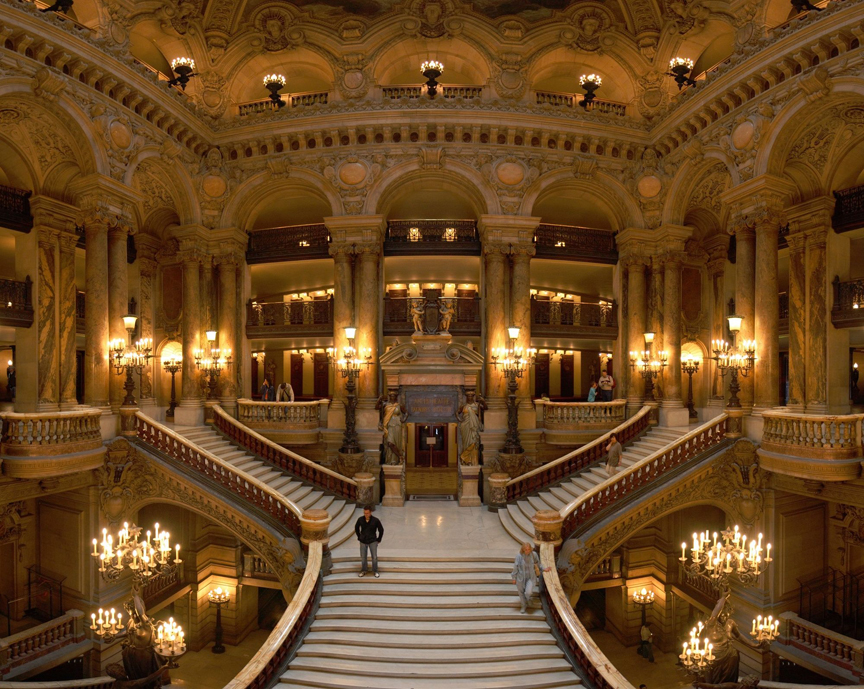

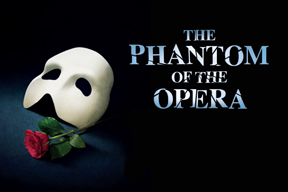 Among the legends surrounding the Opera is that of the “Phantom of the Opera,” and there is actually an audience box alleged to be the one where this Phantom appeared (and perhaps still does so now and then for the tourists). I put this in the same category as “Juliet’s Balcony” which we saw in Verona. The guides there insist that the (fictional) Juliet was wooed at that spot by (the equally non-existent) Romeo. So the Phantom’s box seat still draws the tourists in; I wonder if Andrew Lloyd Weber gets royalties?
Among the legends surrounding the Opera is that of the “Phantom of the Opera,” and there is actually an audience box alleged to be the one where this Phantom appeared (and perhaps still does so now and then for the tourists). I put this in the same category as “Juliet’s Balcony” which we saw in Verona. The guides there insist that the (fictional) Juliet was wooed at that spot by (the equally non-existent) Romeo. So the Phantom’s box seat still draws the tourists in; I wonder if Andrew Lloyd Weber gets royalties?
 I first went to Paris fifty-two years ago, and so much has changed since then. For one thing it’s obvious that in a few more decades English will be the world’s common language: in 1966 hardly anyone spoke English outside people working at a few some tourist sites, but today most French people seem to have at least some ability to do so. The Académie Française hates it, but “Franglais,” the melding of French and English into a—pardon the expression—lingua franca is unstoppable. Some words are universal now: “le parking,” “le weekend,” “les shorts,” and many others are examples. A lot of untranslated English is used in advertising, to judge by the billboards in the Métro. No doubt the sages of the Académie are tearing out their hair but there isn’t anything they can do to prevent this “degradation” of the language from continuing.
I first went to Paris fifty-two years ago, and so much has changed since then. For one thing it’s obvious that in a few more decades English will be the world’s common language: in 1966 hardly anyone spoke English outside people working at a few some tourist sites, but today most French people seem to have at least some ability to do so. The Académie Française hates it, but “Franglais,” the melding of French and English into a—pardon the expression—lingua franca is unstoppable. Some words are universal now: “le parking,” “le weekend,” “les shorts,” and many others are examples. A lot of untranslated English is used in advertising, to judge by the billboards in the Métro. No doubt the sages of the Académie are tearing out their hair but there isn’t anything they can do to prevent this “degradation” of the language from continuing.
Another huge change is in clothing styles. You used to be able to spot Americans by the way they dressed, but thanks to the universal impact of American TV shows and pop culture nowadays everyone wears the same clothes bearing the same logos and brand names. (Actually, sometimes the “brand names” are of non-existent companies, and sometimes the shirts have meaningless slogans on them: “Genuine Article” or “Persistent” are examples). So just as you can’t judge a book by its cover, these days you generally can’t spot a tourist or a native by what he or she is wearing in casual clothing. Some degree of distinction remains in business attire: French business men wear suits and ties but once the work day is over, they take off their ties.
American commercial brands have made enormous inroads, as you might expect: in Paris you can not only find MacDonald’s, but Burger King, Subway, Kentucky Fried Chicken, and even Five Guys franchises. Oddly, not once did I see a sign advertising Coca-Cola, though you can certainly get it in bars. On my first trip Coke advertising was everywhere.
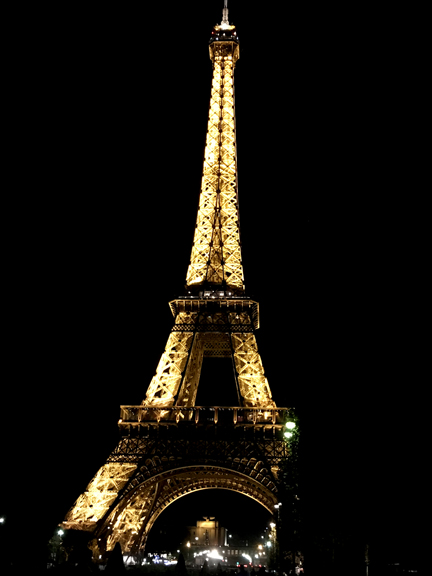 These days there is construction and/or reconstruction everywhere you go. Building facades are covered with tarps and scaffolds, high-lift cranes are all over the city, and renovation and reconditioning are underway at almost every street corner. Any big city is constantly renewing itself but the pace in Paris is greater even than it is in New York.
These days there is construction and/or reconstruction everywhere you go. Building facades are covered with tarps and scaffolds, high-lift cranes are all over the city, and renovation and reconditioning are underway at almost every street corner. Any big city is constantly renewing itself but the pace in Paris is greater even than it is in New York.
There is far more traffic than I remember, much of which is motorcycles. Not the little wasp-like ones the Italians ride, but big, roaring monsters with loud exhausts. In movies you see people sitting at quaint, quiet Parisian cafés drinking wine while watching strolling passersby: in fact there are outdoors cafés everywhere but most of them are on major streets with huge amounts of traffic passing by in a noisy parade fit to destroy your eardrums.
Paris seems to be winning the war against graffiti, at least in the downtown areas. On our last trip about 7 or 8 years ago I was horrified at the level of graffiti everywhere we went. But much of it is gone. I hope it was scrubbed off by chain gangs of taggers who have been rounded up and made to erase their handiwork before being sent to Devil’s Island. It’s as bad as ever along the highways leading out of the city but in town itself the plague has abated a great deal. That was one of the pleasant surprises of this trip.
Non, Je ne regrette rien.
| HUNTING | GUNS | DOGS |
| FISHING & BOATING | TRIP REPORTS | MISCELLANEOUS ESSAYS |
| CONTRIBUTIONS FROM OTHER WRITERS|
| RECIPES | POLITICS |
 Experience has taught us it’s best to arrive a few days before the cruise because there is almost always a jam-up at the airport for passport control and customs. On one trip we landed at Charles de Gaulle (CDG) about 7:30 AM, along with two or three other jumbo jets: there was one, count ‘em, one passport clerk on duty to handle about a thousand people! In consequence we missed a connecting flight to Marseilles and almost a full day aboard the boat. Now, more savvy, we get there well in advance. So we planned a few days in Paris as a pre-cruise excursion.
Experience has taught us it’s best to arrive a few days before the cruise because there is almost always a jam-up at the airport for passport control and customs. On one trip we landed at Charles de Gaulle (CDG) about 7:30 AM, along with two or three other jumbo jets: there was one, count ‘em, one passport clerk on duty to handle about a thousand people! In consequence we missed a connecting flight to Marseilles and almost a full day aboard the boat. Now, more savvy, we get there well in advance. So we planned a few days in Paris as a pre-cruise excursion.  Viking is incredibly well organized and efficient and they have enough clout to get us good air fares and hotel choices. For the pre-cruise segment they booked us on Air France (coincidentally, this was the airline I used for my first trip to Paris as a teenager in 1966). Air France is better than some other companies, at least with respect to food, though since they fly the same aircraft everyone else does, I spent a pretty ghastly 8 hours in a coach seat that could have been used by the Spanish Inquisition to interrogate heretics. As a result my right-side sciatica was kicked into high gear and I had a horribly painful leg the whole trip: but I survived to tell the tale (obviously: I’m telling it here, yes?). We landed at CDG in the early morning and were met by Viking’s people, who conveyed us to a very nice hotel on the Boulevard Haussmann, a pretty tony address. We parked our bags and embarked on a bit of sightseeing. Giving in to jet lag on Day One is always inadvisable so we force ourselves onto local time.
Viking is incredibly well organized and efficient and they have enough clout to get us good air fares and hotel choices. For the pre-cruise segment they booked us on Air France (coincidentally, this was the airline I used for my first trip to Paris as a teenager in 1966). Air France is better than some other companies, at least with respect to food, though since they fly the same aircraft everyone else does, I spent a pretty ghastly 8 hours in a coach seat that could have been used by the Spanish Inquisition to interrogate heretics. As a result my right-side sciatica was kicked into high gear and I had a horribly painful leg the whole trip: but I survived to tell the tale (obviously: I’m telling it here, yes?). We landed at CDG in the early morning and were met by Viking’s people, who conveyed us to a very nice hotel on the Boulevard Haussmann, a pretty tony address. We parked our bags and embarked on a bit of sightseeing. Giving in to jet lag on Day One is always inadvisable so we force ourselves onto local time.  On the first day we took a sightseeing bateau-mouche (“butterfly boat”) ride on the Seine. This might have been considered gilding the lily since we were, after all, going to spend a week on the river; but Viking’s boats can’t come all the way up to Paris proper (the bridges are too low) so we did this classic tourist ride through the city. There was no way were we going to wait to go up in the Eiffel Tower, but the bateau-mouche dock was near it, so we rode the Métro to the nearest stop—which turned out to be a good 1000 yards away from the dock. Upon return to the dock we were pretty well beat so we took a taxi back to the hotel and crashed.
On the first day we took a sightseeing bateau-mouche (“butterfly boat”) ride on the Seine. This might have been considered gilding the lily since we were, after all, going to spend a week on the river; but Viking’s boats can’t come all the way up to Paris proper (the bridges are too low) so we did this classic tourist ride through the city. There was no way were we going to wait to go up in the Eiffel Tower, but the bateau-mouche dock was near it, so we rode the Métro to the nearest stop—which turned out to be a good 1000 yards away from the dock. Upon return to the dock we were pretty well beat so we took a taxi back to the hotel and crashed.  We also visited Ste Chappelle, a smaller church not too far from the much more famous Nôtre Dame Cathedral. It’s known for its stained glass windows and remarkable blue color scheme.
We also visited Ste Chappelle, a smaller church not too far from the much more famous Nôtre Dame Cathedral. It’s known for its stained glass windows and remarkable blue color scheme.  The chapel is located inside a government complex, so we again had to go through “security,” which demonstrated that the French take this (at least at tourist sites) no more seriously than the TSA does. We ate lunch in an outdoor café on the bank of the river, during which a remarkable thing happened. As we were sitting there a man walked past and snatched some bread from the basket we had on our table! Just walked by and grabbed it without stopping, not so much as a by-your-leave. I felt that if he was so hungry he had to steal bread from tourists he needed it more than I did, and he was welcome to it, but it was a bit off-putting. If he’d asked I’d have given it to him.
The chapel is located inside a government complex, so we again had to go through “security,” which demonstrated that the French take this (at least at tourist sites) no more seriously than the TSA does. We ate lunch in an outdoor café on the bank of the river, during which a remarkable thing happened. As we were sitting there a man walked past and snatched some bread from the basket we had on our table! Just walked by and grabbed it without stopping, not so much as a by-your-leave. I felt that if he was so hungry he had to steal bread from tourists he needed it more than I did, and he was welcome to it, but it was a bit off-putting. If he’d asked I’d have given it to him. There are any number of beggars in Paris. You would think that in France, a country which has what is in essence a Socialist mindset and government (no matter what party is in power) this wouldn’t be the case, but they’re very common: no matter how high-end the area may be. In fact there are support systems available, as
There are any number of beggars in Paris. You would think that in France, a country which has what is in essence a Socialist mindset and government (no matter what party is in power) this wouldn’t be the case, but they’re very common: no matter how high-end the area may be. In fact there are support systems available, as  The Galeries Lafayette is a huge place with every high-dollar (well, high-Euro) brand name item you ever heard of. It's actually a nationwide chain, sort of like Macy's. We ran across their stores in other places besides Paris.
The Galeries Lafayette is a huge place with every high-dollar (well, high-Euro) brand name item you ever heard of. It's actually a nationwide chain, sort of like Macy's. We ran across their stores in other places besides Paris.  One night Viking had set us up to go to a cabaret show at a place called “
One night Viking had set us up to go to a cabaret show at a place called “ My sister had had recently been to Paris and she'd recommended we visit a museum dedicated to the Impressionist painter Monet: L’Orangerie. This was originally built as a greenhouse to protect imported orange trees from the winters of Northern France; it’s far and away the most elegant greenhouse I’ve ever seen, but now it’s an art museum. We had audio guides with running commentary on the paintings we saw. These comments made me wonder why people who talk about art are so amazingly pretentious, even worse than wine critics. I’ve never understood why a painting can’t be accepted for what it is and what the viewer sees in it, why it has to be “interpreted” and layer upon layer of “meaning” attributed to it.
My sister had had recently been to Paris and she'd recommended we visit a museum dedicated to the Impressionist painter Monet: L’Orangerie. This was originally built as a greenhouse to protect imported orange trees from the winters of Northern France; it’s far and away the most elegant greenhouse I’ve ever seen, but now it’s an art museum. We had audio guides with running commentary on the paintings we saw. These comments made me wonder why people who talk about art are so amazingly pretentious, even worse than wine critics. I’ve never understood why a painting can’t be accepted for what it is and what the viewer sees in it, why it has to be “interpreted” and layer upon layer of “meaning” attributed to it.  One modern painting in the collection had an especially annoying commentary. It was a group of daubs that could have been made by a kindergartner, but the commentary waxed lyrical about it and described it as an "homage" to Monet’s imagery. I include a picture of this “art” and my readers can make up their own minds about whether or not it’s some sort of practical joke by the “artist,” who was undoubtedly paid a handsome sum by the museum.
One modern painting in the collection had an especially annoying commentary. It was a group of daubs that could have been made by a kindergartner, but the commentary waxed lyrical about it and described it as an "homage" to Monet’s imagery. I include a picture of this “art” and my readers can make up their own minds about whether or not it’s some sort of practical joke by the “artist,” who was undoubtedly paid a handsome sum by the museum. 
 We had hoped to see the Opera Garnier, but it was closed, so that had to be saved for the return to Paris (see below). Instead we took the Métro to the Pere Lachaise Cemetery. Many famous people are buried there, including such luminaries as Oscar Wilde and the “Doors” singer Jim Morrison. The grave I wanted to see was that of Edith Piaf, the iconic French singer whose rendition of “La Vie en Rose” is so closely associated with France (especially Paris) that it is played even more than “La Marseillaise.” She is without doubt the most famous “resident” of this necropolis, and her grave is kept more or less as a shrine, where fans (most of whom were born after her death) leave flowers and tributes. We saw the same phenomenon in Buenos Aires at Eva Peron’s tomb.
We had hoped to see the Opera Garnier, but it was closed, so that had to be saved for the return to Paris (see below). Instead we took the Métro to the Pere Lachaise Cemetery. Many famous people are buried there, including such luminaries as Oscar Wilde and the “Doors” singer Jim Morrison. The grave I wanted to see was that of Edith Piaf, the iconic French singer whose rendition of “La Vie en Rose” is so closely associated with France (especially Paris) that it is played even more than “La Marseillaise.” She is without doubt the most famous “resident” of this necropolis, and her grave is kept more or less as a shrine, where fans (most of whom were born after her death) leave flowers and tributes. We saw the same phenomenon in Buenos Aires at Eva Peron’s tomb.
 Before leaving regulations mandate an "abandon ship" drill be held, in which all passengers are required to wear life jackets and assemble at their assigned stations. This we did, though considering that we were never more than 100 yards from the well-populated river banks on either side, and that the water is at most 12-15 feet deep, it seemed most unlikely that anyone would have trouble getting saved if somehow the boat foundered.
Before leaving regulations mandate an "abandon ship" drill be held, in which all passengers are required to wear life jackets and assemble at their assigned stations. This we did, though considering that we were never more than 100 yards from the well-populated river banks on either side, and that the water is at most 12-15 feet deep, it seemed most unlikely that anyone would have trouble getting saved if somehow the boat foundered. 


 English gardens, in
English gardens, in  disciplined ranks and rows by type; rather they were all crowded in upon one another higgledy-piggledy, but we were supposed to admire them, so we dutifully did so. The Monet site was also heavily attended by Asian tourists, who crowded the narrow paths around the famous water gardens and made me grateful that we had chosen the off season, or we’d probably have been knocked into the pond.
disciplined ranks and rows by type; rather they were all crowded in upon one another higgledy-piggledy, but we were supposed to admire them, so we dutifully did so. The Monet site was also heavily attended by Asian tourists, who crowded the narrow paths around the famous water gardens and made me grateful that we had chosen the off season, or we’d probably have been knocked into the pond. 










 right down to the sheep the lady who ran it kept as "lawn mowers." Naturally, since she had sheep, she also had a lovely Border Collie (who looked just like my Lucy) and all in all it was a very idyllic setting on a perfect day.
right down to the sheep the lady who ran it kept as "lawn mowers." Naturally, since she had sheep, she also had a lovely Border Collie (who looked just like my Lucy) and all in all it was a very idyllic setting on a perfect day. 







 Chartres for 65 years and is the world’s leading authority on the Cathedral, its history, its architecture, and significance.
Chartres for 65 years and is the world’s leading authority on the Cathedral, its history, its architecture, and significance.  When we arrived there were a thousand or more Scouts, boys and girls from all over Europe ranging in age from about 8 to 18. They were all in the building attending a Mass and had left their backpacks outside, hundreds upon hundreds of them piled up. We were told these were “pilgrims,” actually. After an hour or so they came streaming out in orderly groups, waving flags and singing, though I don’t know if they were singing religious, patriotic, or scouting-camp songs. Certainly none of them were singing “La Marseillaise” or “La Vie en Rose,” anyway. They picked up their packs and off they trooped to wherever they were staying, in perfect order, and we went in to
When we arrived there were a thousand or more Scouts, boys and girls from all over Europe ranging in age from about 8 to 18. They were all in the building attending a Mass and had left their backpacks outside, hundreds upon hundreds of them piled up. We were told these were “pilgrims,” actually. After an hour or so they came streaming out in orderly groups, waving flags and singing, though I don’t know if they were singing religious, patriotic, or scouting-camp songs. Certainly none of them were singing “La Marseillaise” or “La Vie en Rose,” anyway. They picked up their packs and off they trooped to wherever they were staying, in perfect order, and we went in to  hear Mr Miller’s talk and explanation of the stories told in the stained glass windows.
hear Mr Miller’s talk and explanation of the stories told in the stained glass windows. 
 That night I had an interesting dinner. I spotted an item on the menu of andouillette, and ordered it. Now, “andouille” is a form of spicy sausage I like a great deal, but andouillette isn’t quite the same. It’s sausage, all right: but instead of a pig’s intestine stuffed with spiced ground meat, it’s a pig’s intestine stuffed with….a pig’s intestines. It’s a sort of grilled tripe-filled-with-tripe. A little chewy but good, and unlike the flaccid so-called “pork” we get in the USA, it actually tasted like pork. It was very flavorful and I would certainly order it again. Not so the dish my wife had the second night: rognon de veau. I knew the word “veau” mean “veal” but I didn’t know the word “rognon,” which turned out to be kidneys. Stewed calf kidneys. Kidneys. These had a sort of rubbery consistency, and were more or less flavorless: they didn’t even taste of urine, which might have been expected. It was a very disappointing dish and neither of us liked it. But one of the reasons to travel is to experience new things, right?
That night I had an interesting dinner. I spotted an item on the menu of andouillette, and ordered it. Now, “andouille” is a form of spicy sausage I like a great deal, but andouillette isn’t quite the same. It’s sausage, all right: but instead of a pig’s intestine stuffed with spiced ground meat, it’s a pig’s intestine stuffed with….a pig’s intestines. It’s a sort of grilled tripe-filled-with-tripe. A little chewy but good, and unlike the flaccid so-called “pork” we get in the USA, it actually tasted like pork. It was very flavorful and I would certainly order it again. Not so the dish my wife had the second night: rognon de veau. I knew the word “veau” mean “veal” but I didn’t know the word “rognon,” which turned out to be kidneys. Stewed calf kidneys. Kidneys. These had a sort of rubbery consistency, and were more or less flavorless: they didn’t even taste of urine, which might have been expected. It was a very disappointing dish and neither of us liked it. But one of the reasons to travel is to experience new things, right?  driver had showed up, very apologetic because he’d been held up in the insane Parisian traffic and had had to park “a long way away”. Boy, did he ever: we must have hoofed it through 2 kilometers (no kidding) of the train station before we got to his car, all the while dragging luggage through a steel-and-glass rabbit warren, never once getting outdoors. I don't know how he found his way to the car without a GPS, actually. He drove us to a hotel which was pretty bare-bones but spotlessly clean and very comfortable. It was in the Cité Bergère, a very quiet side alley coming off a main street with the usual roaring traffic. Around the corner we went to a restaurant where I had an item on the menu that translated as “mouse of lamb.” Wondering what on earth that might be, I ordered it: it was a small lamb shank. Looking at it, a triangular chunk of meat with a long bone sticking out like a tail, it did look a bit like a mouse, and was very good.
driver had showed up, very apologetic because he’d been held up in the insane Parisian traffic and had had to park “a long way away”. Boy, did he ever: we must have hoofed it through 2 kilometers (no kidding) of the train station before we got to his car, all the while dragging luggage through a steel-and-glass rabbit warren, never once getting outdoors. I don't know how he found his way to the car without a GPS, actually. He drove us to a hotel which was pretty bare-bones but spotlessly clean and very comfortable. It was in the Cité Bergère, a very quiet side alley coming off a main street with the usual roaring traffic. Around the corner we went to a restaurant where I had an item on the menu that translated as “mouse of lamb.” Wondering what on earth that might be, I ordered it: it was a small lamb shank. Looking at it, a triangular chunk of meat with a long bone sticking out like a tail, it did look a bit like a mouse, and was very good. 


 Among the legends surrounding the Opera is that of the “Phantom of the Opera,” and there is actually an audience box alleged to be the one where this Phantom appeared (and perhaps still does so now and then for the tourists). I put this in the same category as “Juliet’s Balcony” which we saw in Verona. The guides there insist that the (fictional) Juliet was wooed at that spot by (the equally non-existent) Romeo. So the Phantom’s box seat still draws the tourists in; I wonder if Andrew Lloyd Weber gets royalties?
Among the legends surrounding the Opera is that of the “Phantom of the Opera,” and there is actually an audience box alleged to be the one where this Phantom appeared (and perhaps still does so now and then for the tourists). I put this in the same category as “Juliet’s Balcony” which we saw in Verona. The guides there insist that the (fictional) Juliet was wooed at that spot by (the equally non-existent) Romeo. So the Phantom’s box seat still draws the tourists in; I wonder if Andrew Lloyd Weber gets royalties?  I first went to Paris fifty-two years ago, and so much has changed since then. For one thing it’s obvious that in a few more decades English will be the world’s common language: in 1966 hardly anyone spoke English outside people working at a few some tourist sites, but today most French people seem to have at least some ability to do so. The Académie Française hates it, but “Franglais,” the melding of French and English into a—pardon the expression—lingua franca is unstoppable. Some words are universal now: “le parking,” “le weekend,” “les shorts,” and many others are examples. A lot of untranslated English is used in advertising, to judge by the billboards in the Métro. No doubt the sages of the Académie are tearing out their hair but there isn’t anything they can do to prevent this “degradation” of the language from continuing.
I first went to Paris fifty-two years ago, and so much has changed since then. For one thing it’s obvious that in a few more decades English will be the world’s common language: in 1966 hardly anyone spoke English outside people working at a few some tourist sites, but today most French people seem to have at least some ability to do so. The Académie Française hates it, but “Franglais,” the melding of French and English into a—pardon the expression—lingua franca is unstoppable. Some words are universal now: “le parking,” “le weekend,” “les shorts,” and many others are examples. A lot of untranslated English is used in advertising, to judge by the billboards in the Métro. No doubt the sages of the Académie are tearing out their hair but there isn’t anything they can do to prevent this “degradation” of the language from continuing.  These days there is construction and/or reconstruction everywhere you go. Building facades are covered with tarps and scaffolds, high-lift cranes are all over the city, and renovation and reconditioning are underway at almost every street corner. Any big city is constantly renewing itself but the pace in Paris is greater even than it is in New York.
These days there is construction and/or reconstruction everywhere you go. Building facades are covered with tarps and scaffolds, high-lift cranes are all over the city, and renovation and reconditioning are underway at almost every street corner. Any big city is constantly renewing itself but the pace in Paris is greater even than it is in New York.